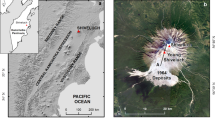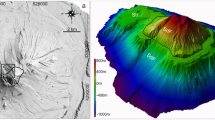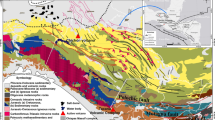Abstract
Pacaya is an active stratovolcano located 30 km south of Guatemala City, Guatemala. A large (0.65 km3) sector collapse of the volcano occurred 0.6–1.6 ka B.P., producing a debris avalanche that traveled 25 km SW of the edifice. The current cone has since rebuilt within the scarp of this ancestral collapse. The structural setting of the volcano, along with two recent smaller-volume collapses in 1962 and 2010, suggests gravitational instability of this volcano. To assess Pacaya’s stability and potential for another large lateral collapse of the active cone, standard engineering methodologies for studying non-volcanic slopes were used to examine the SW flank of the edifice. A geomechanical model was developed based on the physical–mechanical material properties of Pacaya’s intact rocks and rock mass characteristics found through field observations and laboratory tests. Slope stability was analyzed in several scenarios with the Limit Equilibrium Method (LEM) and Finite Element Method (FEM), including static conditions (i.e., under gravity forces only), and considering the application of magma pressure and seismic force as triggering mechanisms for slope failure. Results show that the edifice remains stable under gravity alone; however, a large-scale collapse could be triggered by reasonable ranges of magma pressure (≥7.7 MPa if constant along a dyke) or peak ground acceleration (≥460 cm/s2). Results also suggest that a layer of pyroclastics beneath the edifice could have controlled the ancestral sector collapse. Structural analysis shows that a transtensional stress regime is causing a NW–SE orientation of aligned features at the surface, and may be a controlling mechanism for the direction of a future collapse. FEM results are concordant with those from LEM and reveal that maximum shear strain patterns within the edifice may account for long lava flows erupted from lower vent elevations.











Similar content being viewed by others
References
Álvarez-Gómez JA, Meijer PT, Martínez-Díaz JJ, Capote R (2008) Constraints from finite element modeling on the active tectonics of northern Central America and the Middle America Trench. Tectonics 27:1–12
Apuani T, Corazzato C (2009) Numerical model of the Stromboli volcano (Italy) including the effect of magma pressure in the dyke system. Rock Mech Rock Eng 42(1):53–72
Apuani T, Corazzato C, Cancelli A, Tibaldi A (2005a) Physical and mechanical properties of rock masses at Stromboli: a dataset for volcano instability evaluation. Bull Eng Geol Environ 64:419–431
Apuani T, Corazzato C, Cancelli A, Tibaldi A (2005b) Stability of a collapsing volcano (Stromboli-Italy): limit equilibrium analysis and numerical modelling. J Volcanol Geotherm Res 144(1–4):191–210
Apuani T, Merri A, Masetti M (2007) Effects of volcanic seismic events on the Stromboli stability by finite difference numerical modeling. In: Proceedings of the International Workshop on Volcanic Rocks, 11th ISRM Congress. Ponta Delgada, Azores, Portugal, pp. 101–109
Bardinezteff JM, Deniel C (1992) Magmatic evolution of Pacaya and Cerro Chiquito volcanological complex, Guatemala. Bull Volcanol 54:267–283
Benito MB, Lindholm C, Camacho E, Climent Á, Marroquín G, Molina E, Rojas W, Escobar JJ, Talavera E, Alvarado GE, Torres Y (2012) A new evaluation of seismic hazard for the Central America region. Bull Seismol Soc Am 102(2):504–523
Bieniawski ZT (1989) Engineering rock mass classifications. Wiley, New York, p 272
Bonali F, Corazzato C, Tibaldi A (2011) Identifying rift zones on volcanoes: an example from La Réunion island, Indian Ocean. Bull Volcanol 73:347–366
Borgia A, Ferrari L, Pasquare G (1992) Importance of gravitational spreading in the tectonic and volcanic evolution of Mount Etna. Nature 357:231–235
Burkhart B, Self S (1985) Extension and rotation of crustal blocks in northern Central America and effect on the volcanic arc. Geology 13:22–26
Caceres D, Monterroso D, Tavakoli B (2005) Crustal deformation in northern Central America. Tectonophysics 404:119–131
Carr M (1976) Underthrusting and Quaternary faulting in northern Central America. Geol Soc Am Bull 87:825–829
Corazzato C, Francalanci L, Menna M, Petrone C, Renzulli A, Tibaldi A, Vezzoli L (2008) What controls sheet intrusion in volcanoes? Petrological and structural characters of the Stromboli sheet complex, Italy. J Volcanol Geotherm Res 173:26–54
del Potro R, Hürlimann M (2008) Geotechnical classification and characterization of materials for stability analyses of large volcanic slopes. Eng Geo 98:1–17
Delcamp A, Wyk V, de Vries B, James MR (2008) The influence of edifice slope and substrata on volcano spreading. J Volcanol Geotherm Res 177(4):925–943
Dinçer I, Altay A, Çobanoglu I, Uras Y (2004) Correlation between Schmidt hardness, uniaxial compressive strength and Young’s modulus for andesites, basalts, and tuffs. Bull Eng Geol Environ 63:141–148
Eggers A (1972) The geology and petrology of the Amatitlán Quadrangle, Guatemala. PhD Dissertation, Dartmouth College
Eggers A (1983) Temporal gravity and elevation changes at Pacaya volcano, Guatemala. J Volcanol Geotherm Res 19:223–237
Feldman LH (1993) Mountains of fire, lands that shake: earthquakes and volcanic eruptions in the historic past of Central America, 1505-1899. Labyrinthos, Culver City, CA, p. 295
Franco A, Lasserre C, Lyon-Caen H, Kostoglodov V, Molina E, Guzman-Speziale M, Monterroso D, Robles V, Figueroa C, Amaya W, Barrier E, Chiquin L, Moran S, Flores O, Romero J, Santiago JA, Manea M, Manea VC (2012) Fault kinematics in northern Central America and coupling along the subduction interface of the Cocos Plate, from GPS data in Chiapas (Mexico), Guatemala and El Salvador: kinematics in northern Central America. Geophys J Int 189(3):1223–1236
Frank D (1995) Surficial extent and conceptual model of hydrothermal system at Mount Rainier. Washington. J Volcanol Geotherm Res 65:51–80
Guzman-Speziale M (2001) Active seismic deformation in the grabens of northern Central America and its relationship to the relative motion of the North America-Caribbean plate boundary. Tectonophysics 337:39–51
Hoek E (1994) Strength of rock and rock masses. ISRM News J 2(2):4–16
Hoek E (2007) Practical rock engineering. PDF: wwwrocsciencecom/eduction/hoeks_corner. Accessed 8 Aug 2012
Hoek E, Carranza-Torres C, Corkum B (2002) Hoek-Brown failure criterion—2002 edition. Proc NARMS-TAC Conf 1:267–273
Hungr O, Salgado FM, Byrne M (1989) Evaluation of three-dimensional method of slope stability analysis. Can Geotech J 26:679–686
Hynes ME, Franklin AG (1984) Rationalizing the Seismic Coefficient Method. U.S. Department of the Army. Waterways Experiment Station. US Army Corps of Engineers, Miscellaneous Paper GL-84-13
IGN, Bonis S (1993) Mapa geologico de Guatemala escala 1:250,000. Hoja ND 15-8-G, “Guatemala”. First edition (map), Guamatala
IGN, Eggers A (1969) Mapa geologico de Guatemala escala 1:50,000. Hoja 2059 II G, “Amatitlan”. First edition (map), Guatemala
Iverson R (1995) Can magma-injection and groundwater forces cause massive landslides on Hawaiian volcanoes? J Volcanol Geotherm Res 66:295–308
JICA, INSIVUMEH, SEGEPLAN (2003) Estudio del establecimiento de los mapas básicos de amenaza para el sistema de información geográfica de la República de Guatemala. In: Final report executive abstract (unpublished): 206 p
Kitamura S, Matías Gómez RO (1995) Tephra stratigraphic approach to the eruptive history of Pacaya volcano, Guatemala. Science Reports—Tohoku University, Seventh Series. Geography 45(1):1–41
Lagmay AMF, Valdivia W (2006) Regional stress influence on the opening direction of crater amphitheaters in Southeast Asian volcanoes. J Volcanol Geotherm Res 158:139–150
Lyon-Caen H, Barrier E, Lasserre C, Franco A, Arzu I, Chiquin L, Chiquin M, Duquesnoy T, Flores O, Galicia O, Luna J, Molina E, Porras O, Requena J, Robles V, Romero J, Wolf R (2006) Kinematics of the North America-Caribbean-Cocos plates in Central America from new GPS measurements across the Polochic-Motagua fault system. Geophys Res Lett 33:1–5
Manzoni P (2012) Slope stability analysis of the Pacaya Volcano, Guatemala, using Limit Equilbrium and Finite Element Method. MS thesis, Michigan Technological University
Marinos P, Hoek E (2000) GSI—a geologically friendly tool for rock mass strength estimation. In: Proc. GeoEng 2000 Conference. Melbourne, Australia, pp. 1422–1442
Matías Gómez RO (2009) Volcanological map of the 1961–2009 eruption of Volcán de Pacaya, Guatemala. MS thesis, Michigan Technological University
Matías Gómez RO, Rose WI, Palma JL, Escobar-Wolf R (2012) Notes on a map of the 1961–2010 eruptions of Volcán de Pacaya, Guatemala. Geol Soc Am Digital Map Chart Series 10: 10 p
Merle O, Borgia A (1996) Scaled experiments of volcanic spreading. J Geophys Res 101(B6):805–813
Michalowski RL (2010) Limit analysis and stability charts for 3D slope failures. J Geotech Geo-Environ Eng 136:583–593
Moore JG, Albee WC (1981) Topographic and structural changes, March–July 1980—photogrammetric data. In: Lipman PW, Mullineaux DR (eds). The 1980 eruptions of Mount St. Helens, Washington. US Geol Surv Prof Pap 1250: 401–420
Moriya I (1980) Bandaian eruption and landforms associated with it. In: Collection of articles in memory of retirement of Prof. K. Hishimura. Tohoku University, Tokyo:214–219
Nakamura K (1977) Volcanoes as possible indicators of tectonic stress orientation—principle and proposal. J Volcanol Geotherm Res 2(1):1–16
Nakamura K (1978) Geology and petrology of Bandai and Nekoma volcanoes. Tohoku Univ Sci Rep 14:67–119
Norini G, Acocella V (2011) Analogue modeling of flank instability at Mount Etna: understanding the driving factors. J Geophys Res 116(B07206)
Rocscience (2011) RocLab v1.0, Phase2 v 8.0, Slide v. 6.0. Toronto, Canada
Rubin AM, Pollard DD (1987) Origin of blade-like dykes in volcanic rift zones. In: Decker RW, Wright TL Stauffer PH (eds) Volcanism in Hawaii. US Geol Surv Prof Pap 1350:1449–1470
Schaefer LN (2012) Geotechnical data and numerical analysis of edifice collapse and related hazards at Pacaya Volcano, Guatemala. MS thesis, Michigan Technological University
Siebert L (1984) Large volcanic debris avalances: characteristics of source areas, deposits, and associated eruptions. J Volcanol Geotherm Res 22(3–4):163–197
Siebert L, Béget JE, Glicken H (1995) The 1883 and late-prehistoric eruptions of Augustine volcano, Alaska. J Volcanol Geotherm Res 66:367–395
Siebert L, Glicken H, Ui T (1987) Volcanic hazards from Bezymianny- and Bandai-type eruptions. Bull Volcanol 49(1):435–459
Siebert L, Alvarado GE, Vallance JW, van Wyk de Vries B (2006) Large-volume volcanic edifice failures in Central America and associated hazards. In: Rose WI, Bluth GJS, Carr MJ, Ewert JW, Patino LC, Vallance JW, (eds) Volcanic hazards in Central America. Geol Soc Am Spec Pap 412:1–26
Thomas ME, Petford N, Bromhead EN (2004) Volcanic rock-mass properties from Snowdonia and Tenerife: implications for volcano edifice strength. J Geol Soc 161:939–946
Tibaldi A (2001) Multiple sector collapses at Stromboli Volcano, Italy: how they work. Bull Volcanol 63:112–125
Tibaldi A, Lagmay AMF (2006) Interaction between volcanoes and their basement. J Volcanol Geotherm Res 158:1–5
Tibaldi A, Rust D, Corazzato C, Merri A (2010) Setting the scene for self-destruction: From sheet intrusions to the structural evolution of rifted stratovolcanoes. Geosphere 6(3):189–210
Ui T, Yamamoto H, Suzuki K (1986) Characterization of debris avalanche deposits in Japan. J Volcanol Geotherm Res 29:231–243
Vallance JW, Siebert L, Rose WI, Raul Girón J, Banks NG (1995) Edifice collapse and related hazards in Guatemala. J Volcanol Geotherm Res 66:337–355
Voight B, Elsworth D (1997) Failure of volcano slopes. Geotechnique 47(1):1–31
Walker JA (1989) Caribbean arc tholeiites. J Geophys Res 94:10539–10548
Wooller L, Wyk V, de Vries B, Murray JB, Rymer H, Meyer S (2004) Volcano spreading controlled by dipping substrata. Geology 32:573–576
Wunderman RL, Rose WI (1984) Amatitlán, an actively resurging cauldron 10 km south of Guatemala City. J Geophys Res 89:8525–8539
Acknowledgments
This study was performed in the framework of the USA-Italy-France Atlantis INVOGE (International Geologic Masters in Volcanology and Geotechniques) project, and under the umbrella of the International Lithosphere Program–Task Force II. Additionally, this material is based upon work supported by the National Science Foundation under PIRE Grant No. 0530109 and the Michigan Space Grant Consortium. Thank you to Patrick Manzoni for support in the field and laboratory. Special thanks to Sarah Fagents, Lee Siebert, and an anonymous reviewer for their help in improving this manuscript.
Author information
Authors and Affiliations
Corresponding author
Additional information
Editorial responsibility: S. A. Fagents
Rights and permissions
About this article
Cite this article
Schaefer, L.N., Oommen, T., Corazzato, C. et al. An integrated field-numerical approach to assess slope stability hazards at volcanoes: the example of Pacaya, Guatemala. Bull Volcanol 75, 720 (2013). https://doi.org/10.1007/s00445-013-0720-7
Received:
Accepted:
Published:
DOI: https://doi.org/10.1007/s00445-013-0720-7




